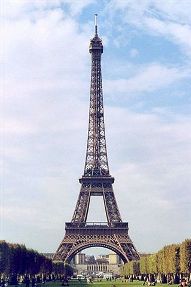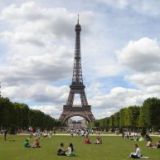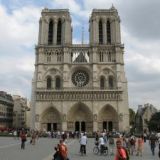History of the Eiffel Tower
The history of the Eiffel Tower is almost as fascinating as the incredible structure itself! First, let's examine exactly what we're talking about. The Eiffel Tower today stands a proud 324 meters (1,063 feet) high. It is made from 18,038 pieces of iron fitted together with three million rivets. Besides attracting million of visitors to Paris each year and in addition to being a source of national pride, showcasing France's technological advancement and beauty, the top of the Eiffel Tower is used today as a radio transmission station, a weather station, a navigation point, and an observation platform. The Eiffel Tower's one-of-a-kind architectural model has been named one of the Seven Wonders of the World and is said to be the most recognized structure in the world.
So where does the history of the Eiffel Tower begin? You might be inclined to guess 'France,' however in fact the tower was initially slated to be built for the city of Barcelona, Spain, where it was to be displayed at the 1888 Universal Exposition. After being rejected by the Barcelona City Hall as unsuitable for the style of the city, Alexander Gustave Eiffel, the engineer who designed the Eiffel Tower, brought his plans to France. It took three years and the help of three men to design the tower. Gustav Eiffel was assisted by engineers and designers Maurice Koechlin, Emile Nouguier, and Stephen Sauvestre. Construction began in 1887 and was completed in 1889. The Eiffel Tower was formerly inaugurated on March 31, 1889, and opened to the public on May 6th of the same year.
 Photo by: Lupo
Photo by: Lupo
You might be surprised to learn what happened next in the history of the Eiffel Tower. The tower was initially constructed as a showpiece for the 1889 Paris Exhibition celebrating the 100th anniversary of the French Revolution. It was not intended to stand for more than a few years, and in fact, due to opposition from some of the French public, it appeared that the Eiffel Tower was doomed for demolition. However it was discovered that the tower served great scientific purposes and it wasn't long before the summit became the site of many weather-related experiments and was used for radio transmission. Over time the people of Paris became enamored with this iconic structure, which remains a testament to the beauty and sophistication of France until this day.
Here are some more fascinating facts about the history of the Eiffel Tower:
- Gustave Eiffel is also credited with designing the Statue of Liberty and several noted metal bridges and railways
- It took two years, two months, and five days to build the Eiffel Tower
- The Eiffel Tower is copper-brown in color and is repainted every seven years using up to 70 tons of paint
- The Eiffel Tower lost its title as the world's tallest structure to the Chrysler Building in 1930
- As a symbol of victory during WWII, German soldiers climbed the tower by foot and hoisted the German flag atop the Eiffel Tower
- Seventy-two names belonging to notable French engineers, scientists, artists, and architects are engraved in the tower
- Today the Eiffel Tower is open year-round, seven days a week









New! Comments
Have your say about what you just read! Leave me a comment in the box below.